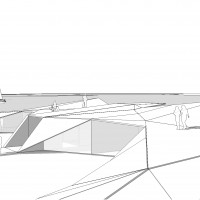Model
Winged Pavilion
Is it a bird, is it a plane?
This proposal for a pavilion at the edge of a lake, near Den Bosch, calls back to the specifics of its location. The lake was one of the first places to be an area for windsurfers. Now it is a bird reserve. The lake, called lake of Angeles, is surrounded by myth and fable of all sorts.
Taking these stories and uses as a reference, a water sports and recreational pavilion was designed with the shape of wings and sails in mind. The wooden roof forms an extension landscape where people can dwell and sun bade. The inside contains facilities for leisure and sports.
To(mato)Can Chair
Made from a tomato can as a small rocking chair for a dollhouse this design grew big years later as a full-size chair.
Schagen’ Eye
A bridge that gaps an earlier made brake in the 126 kilometer long West-frisian dike. It refers to the round shapes called wheels that mark the early brake trough of water. When the footbridge opens it forms a full circle as a homage to the reunion of the earlier break in the dike.
The model (1:500):
The rendered image:
The Guardian, the Sleeper and the Dreamer
Three dikes named Guardian, Sleeper and Dreamer after there function in the landscape, are visually challenging the extreme tidal flow of the Loire-river and therefor emphasise a relation between the Dutch man-made landscape and it’s French opponent. Each dike contains a functional element for the campsite. The visitor can wake up under the shower of the Guardian (Dutch trans: the one who awakes). A bed is placed in the Sleeper. Finally one can sit and dream on the toilet in the Dreamer. Assignment by Estuaire Biennale, Nantes, France for autonomous design of a hide-out on an architecture campsite near the Loire river.
model scale 1:50
WindLight Pavilion
This pavilion functions like a sort of sundial. It shows the movements of the sunlight and the wind on one day and makes it into something to experience through an architectural space.
The entire structure of the facade can rotate due to the wind on its arms. One can enter the space by walking along to its rotation. When inside a small glasshouse made of photo-luminescent material catches the sunbeams coming through the openings in the facade. Because of the rotation combined with the beams of light, a ribbon of luminance raps around the glass house, showing the rhythm and strength of the elements: light and wind.
Rendered images of design:






















